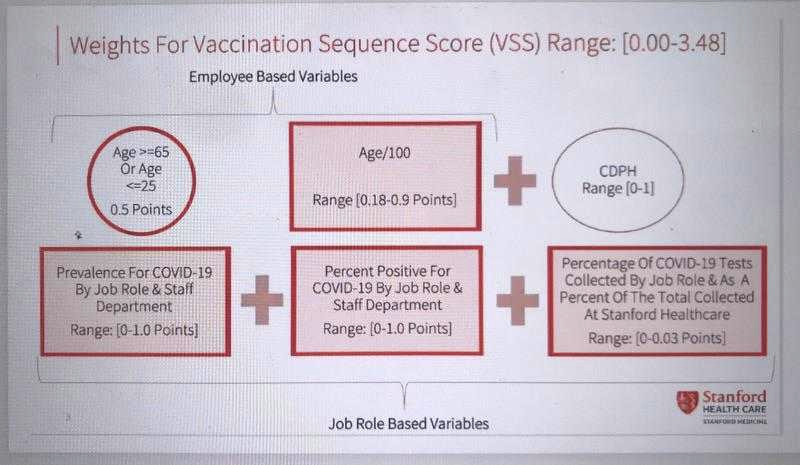
The university hospital blamed a “very complex algorithm” for its unequal vaccine distribution plan. During a planned photo op to celebrate the first vaccinations taking place on Friday, December 18, at least 100 residents showed up to protest.
Many saw that as an excuse, especially since hospital leadership had been made aware of the problem on Tuesday—when only five residents made the list—and responded not by fixing the algorithm, but by adding two more residents for a total of seven.
It is not a complex machine-learning algorithm (which are often referred to as “black boxes”) but a rules-based formula for calculating who would get the vaccine first at Stanford.
It considers three categories:
- “employee-based variables,” which have to do with age
- “job-based variables”
- guidelines from the California Department of Public Health
The algorithm counts the prevalence of covid-19 among employees’ job roles and department in two different ways, but the difference between them is not entirely clear.
Neither the residents nor two unaffiliated experts we asked to review the algorithm understood what these criteria meant, and Stanford Medical Center did not respond to a request for comment. Kahn, who sat on Johns Hopkins’ 20-member committee on vaccine allocation, says his university allocated vaccines based simply on job and risk of exposure to covid-19.
For example, in 2019, a study published in Science showed that 10 widely used algorithms for distributing care in the US ended up favoring white patients over Black ones. As a result, the algorithm allocated less care to Black patients with the same medical conditions as white ones. Irene Chen, an MIT doctoral candidate who studies the use of fair algorithms in health care, suspects this is what happened at Stanford: the formula’s designers chose variables that they believed would serve as good proxies for a given staffer’s level of covid risk.
Hospital representatives did not respond to questions about who they would include in new planning processes, or whether the algorithm would continue to be used. Other department chairs have encouraged residents to get vaccinated first.
Auto283
This is the Stanford vaccine algorithm that left out frontline doctors
3 lessons from Stanford’s Covid-19 vaccine algorithm debacle
A biased medical algorithm favored white people for health-care programs